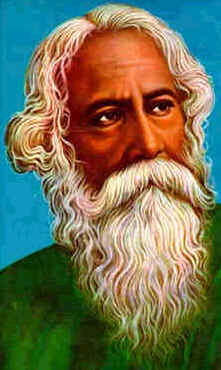
Rabindranath Tagore


 Born
in Calcutta on May 7, 1861, Rabindranath was the youngest of fourteen children.
His father, Debendranath Tagore, was a Sanskrit scholar and a leading member of
the Brahmo Samaj. Rabindranath's early education was imparted at home. In
school, while others use to learn their lessons, he would slip into more
exciting world of dreams. Inspired by his older nephew, he wrote his first poem
when he was hardly seven. At the age of seventeen, his first book of poems was
published. In 1878, he went to England for further studies but returned back in
just seventeen months as he did not find the studies interesting.
Born
in Calcutta on May 7, 1861, Rabindranath was the youngest of fourteen children.
His father, Debendranath Tagore, was a Sanskrit scholar and a leading member of
the Brahmo Samaj. Rabindranath's early education was imparted at home. In
school, while others use to learn their lessons, he would slip into more
exciting world of dreams. Inspired by his older nephew, he wrote his first poem
when he was hardly seven. At the age of seventeen, his first book of poems was
published. In 1878, he went to England for further studies but returned back in
just seventeen months as he did not find the studies interesting.
Rabindranath now started devoting most of his time to writing poems, plays, short stories and novels. In 1883, he got married to Mrinalini Devi. He taught his wife Bengali and Sanskrit.
This period saw Tagore publish a series of works, many based on the
traditional village society of contemporary Bengal. In 1891, Rabindranath went to Shileida and Sayadpur to manage his
father's estates. Living among the rural poor, he became acutely sensitive to
their hardships. Many of the Tagore's themes centre around village life,
introduction of 'western' elements, and their natural surroundings. His 1912
collection Galpa Guccha is based completely on rural Bengal. His other
notable works in this period include Sonar tari, Kalpana and Chitra.
Bengal. In 1891, Rabindranath went to Shileida and Sayadpur to manage his
father's estates. Living among the rural poor, he became acutely sensitive to
their hardships. Many of the Tagore's themes centre around village life,
introduction of 'western' elements, and their natural surroundings. His 1912
collection Galpa Guccha is based completely on rural Bengal. His other
notable works in this period include Sonar tari, Kalpana and Chitra.
Tagore was keenly aware of India's socio-political condition under British rule. He supported the Swadeshi movement and had been deeply influenced by the religious renaissance of 19th century India. Coming out strongly against orthodox ritualism he wrote, "Leave this chanting and singing and telling of beads! Whom dost than worship in this lonely dark corner of a temple with doors all shut? Open thine eyes and see thy God is not before thee!" (Vs 11, Gitanjali)
 In
1901, Tagore established Shantiniketan, (near Bolpur, Bengal) an institution
blending Indian and Western methods of education.
In
1901, Tagore established Shantiniketan, (near Bolpur, Bengal) an institution
blending Indian and Western methods of education.
Tragically, between 1902 and 1907, Tagore lost his wife, son ad daughter. But out of his pain emerged some of his most tender work, including "Gitanjali", published in 1910. This collection of verses, translated into English by the poet himself, non Tagore the 1913 Nobel Prize for Literature. Two years later, Tagore was knighted by the British Empire.
But in 1919, the horror of the Jallianwalla Bagh massacre stunned Tagore and he renounced his title. In a letter to the Viceroy he wrote, "The disproportionate severity of the punishment inflicted upon the unfortunate people and the method of carrying it out, we are convinced, are without parallel in the history of civilized governments and these are the reasons which have painfully compelled me to ask your Excellency to relieve me of my title.. " Tagore remained a true patriot, supporting the national movement and writing the lyrics of the "Jana Gana Mana", which is India's national anthem.
Between 1916 and 1941, Tagore published 21 collections of songs and poems and held lecture tours across Europe, the Americas, China, Japan, Malaya, Indonesia etc ... In 1924, he inaugurated the VISVA BHARATI UNIVERSITY at Shantiniketan, an All India Centre for culture. Tagore died in Calcutta on 7th August, 1941.
Tagore's works are classics, renowned for then lyrical beauty and spiritual poignancy. He is remembered for his literary genius and Shantiniketan remains flourishing institute. In Tagore's own words, "The world speaks to me in colours, my soul answers in music".